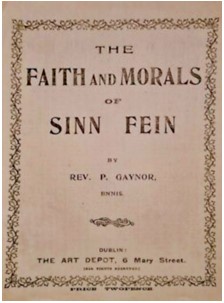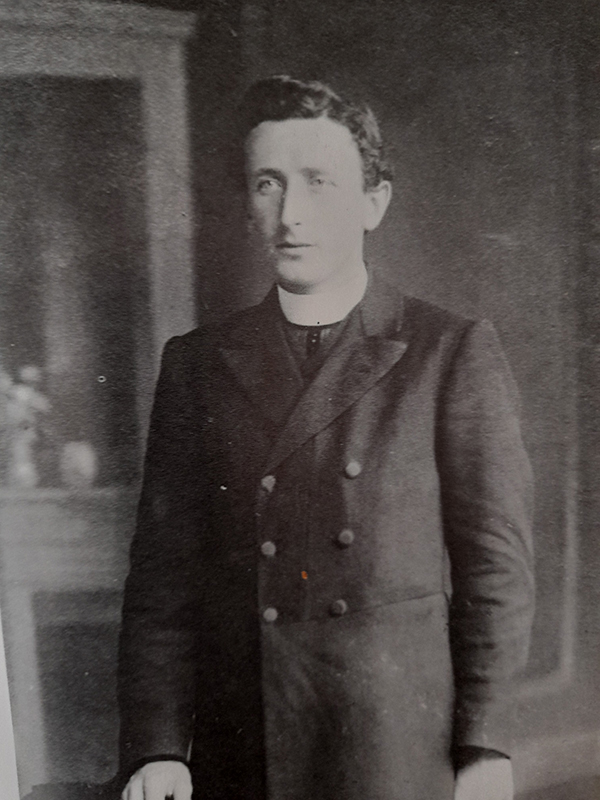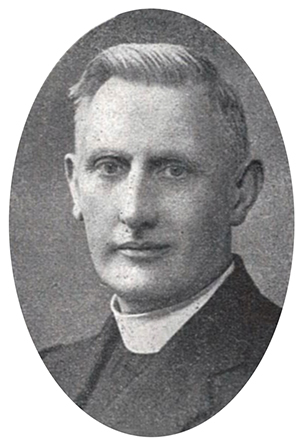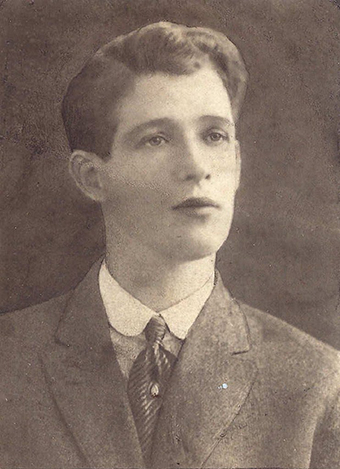The rebel priests of Mullagh—Fr Pat Gaynor, Fr Michael McKenna and the War of Independence
Published in Features, Issue 4 (July/August 2021), Volume 29By Áine Hensey

Above: The faith and morals of Sinn Féin was published by Fr Pat Gaynor (below) in 1917.
In Freedom and the Fifth Commandment: Catholic priests and political violence in Ireland, 1920–21, Brian Heffernan describes the considerable diversity of opinion that existed among Irish Catholic priests during the political and military developments of the years following the 1916 Rising. Particularly intriguing are his references to the unusually revolutionary environment of the curates’ house in Mullagh in west Clare, the home of Fathers Pat Gaynor and Michael McKenna.
Pat Gaynor
Pat Gaynor was born near Nenagh in 1887. On enrolment in Maynooth in 1905 he took an interest in the emerging policies of Arthur Griffith’s Sinn Féin movement. He wrote that
‘… the idea of repudiating British authority by withdrawal from Westminster and of setting up an Irish Parliament in Dublin fascinated our minds as a worthwhile experiment’.
In 1914 he was appointed Killaloe diocesan inspector, a position that, in his own words, allowed him ‘great freedom’ to pursue his interest in the political developments of the day. While he played no active part in the 1916 Rising and was not, in general, a supporter of armed violence, he steadfastly maintained his commitment to the principles of Griffith’s Sinn Féin policy. His first major chance to propagate these ideas came with the East Clare by-election of 1917. Following de Valera’s success, Gaynor gave a lecture in Ennis, explaining in detail how a Sinn Féin parliament in Dublin would function
‘… through the County Councils and District Councils, through Sinn Féin arbitration courts and through the various organised groups in the country’.
This lecture was subsequently published in pamphlet form, under the title The faith and morals of Sinn Féin, and Gaynor was elected to the national executive of the party at its Ard-Fheis in October 1917.

While he had sympathy with most of the activities of the Volunteers, his real interest lay in civil administration. He believed that
‘… maintenance of the whole fabric of local government—collecting rates and holding them safe to meet [the] cost of public institutions and home help and medical services etc.—was much more important than firing shots at (and mostly failing to hit) the British Army of occupation’.
Michael McKenna

Above: Fr Michael McKenna—had enlisted as a chaplain in the British Army in 1915.
In early 1920 Gaynor arrived in the parish of Kilmurry Ibrickane and took up residence in the curates’ house in Mullagh. There he was greeted by Fr Michael McKenna, a fellow alumnus of St Flannan’s College, Ennis, and Maynooth. McKenna’s family home in Tulla, east Clare, was a recognised headquarters for nationalist activity, but the only son of the household took a different route towards involvement in the War of Independence. In 1915 he enlisted as a chaplain in the British Army and served in France for four years.
He is described by Gaynor as a young man who was possessed of ‘reckless courage’. This attribute, as well as his experiences in the trenches of the First World War, led to McKenna’s appointment as commandant of the local battalion of the Volunteers in Mullagh and he was, according to Gaynor, ‘responsible for control of the whole Sinn Féin movement in the parish’.
His fearless nature is revealed in an incident in which a local Quilty man, Michael Casey, organised a cattle drive in opposition to Sinn Féin orders. McKenna faced the mob alone and was hit in the face by a stone. Undaunted, he summoned the Volunteer battalion to march into Quilty the next morning and ‘put the fear of death into Michael Casey’. What is very clear from Gaynor’s account of this time is the extent to which the Sinn Féin institutions functioned as the de facto local government in the area, controlling matters of justice, policing and administration. According to Gaynor, ‘the writ of the Irish Government ran merrily in our jurisdiction’.
Enforcement of Dáil court judgements
In August 1919 the parish priest of Kilmurray Ibrickane, Fr Glynn, had announced the formation of a ‘vigilance committee’ for the safeguarding of parishioners in the absence of the ‘withdrawn police force’. This move was evidently a precursor to the establishment of the ‘republican police’. Shortly after his arrival in Mullagh Gaynor assumed the role of ‘brigade chief-of-police’.
One of the principal roles of this body was the enforcement of judgements handed down by the Dáil district courts. Among the most notorious of these was a case involving a dispute between an elderly couple, the O’Briens of Mullagh, and their nephew, Patrick Connors from Cooraclare. The upshot of this trial, retrial and eventual court martial was that Gaynor decided to place Connors in solitary confinement on the uninhabited Mutton Island, just off the coast at Seafield. Connors was kept there for a month and Gaynor was so pleased with the outcome of this punishment that he ‘had in view to let other disturbers in West Clare see that there was an admirable “Sinn Féin prison” on Mutton Island’.
This did not, however, conclude the Connors saga, as the young man had procured an order allowing him to bring some of the Cooraclare Volunteers into Mullagh to evict his uncle. Disappointed that the local Volunteers did not stand up for the O’Briens, Gaynor summoned a convention of all the authorities under the Irish Republic in west Clare and duly secured a unanimous verdict in favour of the elderly couple.
When he approached Connors in the house and asked him to leave, Connors laughed in his face and said, ‘It will take more than a bloody Tipperary man to put me out’. Gaynor calmly told Connors that he had half an hour to decide whether he wanted to leave the house alive or be carried out dead. Despite being a convinced believer in the policy of non-violence, the curate returned with the rifle-bearing Joe Daly and another two armed Volunteers. He convinced the men that they could open fire on Connors, if necessary, without any qualm of conscience. As they approached the house, Connors was seen running out the back door and heading for Cooraclare.
Non-violence?
This story raises interesting questions about how deeply Gaynor really believed in the efficacy of an exclusively non-violent approach to the building of a republic in Ireland. He argues throughout his memoir that the most potent weapons in forcing the British to seek a truce and negotiations with Sinn Féin were the policy of abstentionism from Westminster, the convening of the first Dáil in Dublin and the establishment of a local administrative structure to effectively remove power from the British institutions, but a closer examination of his story reveals that he consistently justified the acts of sabotage and violence that went hand in hand with that ‘passive resistance’.
Even though he claimed that he never meddled in the affairs of the Volunteers and never attended meetings of the battalion council, there was clearly a certain amount of blurring of lines between the activities of the IRA and his declared roles as Sinn Féin leader, acting chief-of-police and priest. For example, the court martial of Patrick Connors took place in the curates’ house and, even though Gaynor did not attend the hearing, it was his advice that was sought and acted upon with regard to imposing a sentence on the prisoner.
His apparent ambiguity regarding the use of violence may rather be interpreted as an uncertainty about its efficacy. On the one hand he wrote: ‘I did not approve of open war, myself, though I never said a word against the policy; but then I was not a Volunteer and was not free, as a priest, to urge young men into battle when I would not have shared their risks …’. On the other hand, in reaction to the shooting of three armed policemen in Kilmihil in April 1920, Gaynor defended the attack as justified:
‘… since the Irish Government, Dail Éireann, had authorised the Volunteers to attack the British Forces at every opportunity in our war of self-defence … it seems to me—though I thought our appeal to the gun a tactical mistake—that the Volunteers acted within their rights as soldiers of the Irish Army’.
The operation of the Dáil courts was a major component of the strategy to wrest control of local administration from the British authorities and, while Fr Charlie Culligan of Kilmihil was president of the west Clare district court, both Mullagh curates were also heavily involved in its activities.
Only two military operations were recorded in the parish during this period. The first of these followed the shooting of Major Lendrum, a local RM, near Doonbeg. (See HI 18.1, Jan./Feb. 2010, pp 36–7.) Fearful of reprisals, Fr McKenna mobilised his battalion with whatever arms they could muster and the Volunteers kept watch in the village all night.
In Coore, an elderly man believed to have spread untrue rumours about a member of the North Clare flying column was taken out of his house and made to kneel down and say an act of contrition in the belief that he was about to be shot. He was then kicked and released with a warning to keep quiet in future.
Recreation

Above: Ignatius O’Neill, commandant of the 4th Battalion of the Mid-Clare IRA, was cared for in the curates’ house in Mullagh following his wounding at the incident at Crow’s Bridge in February 1920.
Despite the central role of both priests in the religious, political and military activities of the parish, there was still plenty of time for sport. This is how Gaynor describes life in the curates’ house:
‘Gaiety was the order of the day—and of the night—during the mad year and a half which I spent with Fr McKenna in Mullagh. Sometimes I used call a halt, adverting that the Tans might raid the house and find a festive party in the small hours and, worse still, might capture a frequent guest, Ignatius O’Neill, whom they would have burnt to death after the Rineen ambush.’
O’Neill, commandant of the 4th Battalion of the Mid-Clare IRA, had earlier been cared for in the house in Mullagh for two months following his wounding at the incident at Crow’s Bridge in February 1920 that resulted in the shooting dead of Martin Devitt.
‘Friends of the O’Neill family from Miltown and Fr McKenna’s friends from here and there also added to our gaiety in that wild year, when we ought to have been shaking in our shoes at the Black and Tan menace.’
Gaynor describes Michael McKenna as
‘… the life and soul of festive parties and loved by everyone for his gaiety and generosity of heart … I used to feel in Sinn Féin times, that he and his friend, Ignatius O’Neill, were reincarnations of the wildest “Wild Geese” of Ireland and were born to lead forlorn hopes in some fantastic war.’
In the case of O’Neill, it is intriguing that the home of both the commandant of the local Volunteers and a member of the Sinn Féin national executive should be regarded as a ‘safe house’ for one of the area’s most wanted men. It may be indicative of the cautious regard in which the clergy were held by the British authorities that they were granted a certain degree of immunity.
Both arrested; released after the Truce
Following a raid by the Black and Tans on a sitting of the Dáil court in Cragganock, Gaynor was cycling to attend to a number of wounded men when the soldiers raised their rifles towards him. According to Fr Charlie Culligan, only the information that he was a priest saved Gaynor from being shot on the road. When both curates were arrested in a further escalation of the same case, their parish priest hired a motor car and drove to Ennistymon barracks, where he ‘used his great eloquence … threatening papal protest and international complications’. When Gaynor was eventually released, the senior Inspector said, ‘I am at a loss to know what to do with you. You may go, for the present, but you had better be there if we want you.’
Inevitably both priests were eventually summoned to appear for trial before a British court martial in Limerick. Having ignored the summons, Gaynor was arrested in Kilmaley in May 1921 and taken to Limerick jail. The following morning McKenna was detained in the house in Mullagh and, on his arrival in Limerick, strode up to his fellow curate, shook his hand and declared, ‘Begob Pat, you and I have now done nearly everything possible [together] in this world except to get married’. Having refused to recognise the authority of the British court, they were each sentenced to six months in prison for possession of treasonable documents. On their release, following the truce of July 1921, both priests were promoted: Gaynor went to Birr and McKenna to Roscrea.
Neither priest appears to have been involved in the Civil War, and Gaynor wrote with a heavy heart: ‘I never dreamt that the glorious Sinn Féin bid for freedom would end in the miserable fiasco of the Civil War’.
Dr Áine Hensey is a broadcaster and independent researcher.
FURTHER READING
C. Clancy, ‘The experiences of a Sinn Féin priest: Father Pat Gaynor and self-government in Clare, 1919–1921’, The Other Clare (2007), 51–8.
Fr P. Gaynor, The faith and morals of Sinn Féin (Ennis, 1917).
Fr P. Gaynor (ed. É. Gaynor), Memoirs of a Tipperary family: the Gaynors of Tyone, 1887–2000 (Dublin, 2003).
B. Heffernan, Freedom and the Fifth Commandment: Catholic priests and political violence in Ireland, 1920–21 (Manchester, 2014).
















